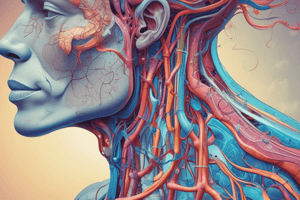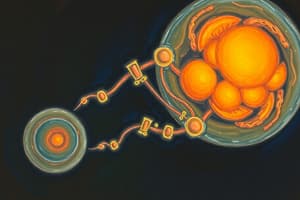Podcast
Questions and Answers
What happens to the oxygen dissociation curve when hemoglobin is oxygenated?
What happens to the oxygen dissociation curve when hemoglobin is oxygenated?
- It shifts to the right. (correct)
- It shifts to the left.
- It remains unchanged.
- It becomes a sigmoid shape.
What is the primary effect of the Haldane effect?
What is the primary effect of the Haldane effect?
- Increased affinity of hemoglobin for CO2.
- Reduction of chloride shift in the tissues.
- Release of CO2 when blood is oxygenated. (correct)
- Inhibition of O2 release in the lungs.
What role does bicarbonate play in carbon dioxide transport?
What role does bicarbonate play in carbon dioxide transport?
- It gets converted to CO2 in the lungs. (correct)
- It directly binds to hemoglobin.
- It acts as an oxygen carrier in the bloodstream.
- It enhances the affinity of hemoglobin for oxygen.
What occurs during the chloride shift in red blood cells?
What occurs during the chloride shift in red blood cells?
Which of the following statements accurately describes the carbon dioxide dissociation curve?
Which of the following statements accurately describes the carbon dioxide dissociation curve?
How does the presence of H+ ions affect hemoglobin's oxygen affinity?
How does the presence of H+ ions affect hemoglobin's oxygen affinity?
How does the partial pressure of CO2 affect oxygen transport?
How does the partial pressure of CO2 affect oxygen transport?
What is the effect of carbon monoxide poisoning on oxygen transport?
What is the effect of carbon monoxide poisoning on oxygen transport?
What is the primary mechanism of oxygen transport in the blood?
What is the primary mechanism of oxygen transport in the blood?
What factor enhances the unloading of oxygen from hemoglobin according to the Bohr effect?
What factor enhances the unloading of oxygen from hemoglobin according to the Bohr effect?
How does the oxygen hemoglobin dissociation curve appear?
How does the oxygen hemoglobin dissociation curve appear?
Which statement correctly describes the chloride shift?
Which statement correctly describes the chloride shift?
What is the role of hemoglobin in oxygen transport?
What is the role of hemoglobin in oxygen transport?
Which conditions lead to a shift to the right in the oxygen hemoglobin dissociation curve?
Which conditions lead to a shift to the right in the oxygen hemoglobin dissociation curve?
What describes the Haldane effect in relation to carbon dioxide transport?
What describes the Haldane effect in relation to carbon dioxide transport?
Which of the following is true about the transport of carbon dioxide in blood?
Which of the following is true about the transport of carbon dioxide in blood?
Which mechanism of carbon dioxide transport occurs in the form of bicarbonate?
Which mechanism of carbon dioxide transport occurs in the form of bicarbonate?
What does an increase in P50 indicate regarding hemoglobin's affinity for oxygen?
What does an increase in P50 indicate regarding hemoglobin's affinity for oxygen?
What occurs during the chloride shift in tissue capillaries?
What occurs during the chloride shift in tissue capillaries?
How is the oxygen dissociation curve affected in cases of anemia?
How is the oxygen dissociation curve affected in cases of anemia?
What effect does CO poisoning have on hemoglobin?
What effect does CO poisoning have on hemoglobin?
What is the primary impact of the Bohr effect on oxygen transport?
What is the primary impact of the Bohr effect on oxygen transport?
What defines the Haldane effect regarding carbon dioxide transport?
What defines the Haldane effect regarding carbon dioxide transport?
What is the normal value for P50 in hemoglobin saturation?
What is the normal value for P50 in hemoglobin saturation?
Flashcards
Oxygen transport in blood
Oxygen transport in blood
Oxygen is transported in blood both dissolved in plasma and bound to hemoglobin.
Hemoglobin's oxygen capacity
Hemoglobin's oxygen capacity
Each gram of hemoglobin can carry 1.34 ml of oxygen.
Bohr effect
Bohr effect
Increased PCO2, temperature, 2,3-DPG, and decreased pH shift the oxygen dissociation curve to the right, enhancing oxygen unloading in tissues.
Oxygen-hemoglobin dissociation curve
Oxygen-hemoglobin dissociation curve
Signup and view all the flashcards
Gas exchange in lungs
Gas exchange in lungs
Signup and view all the flashcards
Partial pressure of oxygen (PO2)
Partial pressure of oxygen (PO2)
Signup and view all the flashcards
Chloride shift
Chloride shift
Signup and view all the flashcards
Alveolar membrane
Alveolar membrane
Signup and view all the flashcards
Hb saturation in anemia vs. CO poisoning
Hb saturation in anemia vs. CO poisoning
Signup and view all the flashcards
Reverse chloride shift in lungs
Reverse chloride shift in lungs
Signup and view all the flashcards
CO2 dissociation curve in venous vs. arterial blood
CO2 dissociation curve in venous vs. arterial blood
Signup and view all the flashcards
Haldane effect
Haldane effect
Signup and view all the flashcards
CO2 release in lungs mechanism
CO2 release in lungs mechanism
Signup and view all the flashcards
Effect of Hb oxygenation on CO2 curve
Effect of Hb oxygenation on CO2 curve
Signup and view all the flashcards
O2 diffusion in lungs
O2 diffusion in lungs
Signup and view all the flashcards
Role of H+ Ions in CO2 release
Role of H+ Ions in CO2 release
Signup and view all the flashcards
Hb Saturation at 100 mmHg PO2
Hb Saturation at 100 mmHg PO2
Signup and view all the flashcards
P50
P50
Signup and view all the flashcards
P50 Normal Value
P50 Normal Value
Signup and view all the flashcards
CO2 Transport in Blood
CO2 Transport in Blood
Signup and view all the flashcards
Anemia and Hb-O2 Binding
Anemia and Hb-O2 Binding
Signup and view all the flashcards
CO Poisoning and Hb-O2 Binding
CO Poisoning and Hb-O2 Binding
Signup and view all the flashcards
Study Notes
Diffusion and Transport of Gases
- Learning Objectives: List mechanisms of oxygen and carbon dioxide transport, describe the reaction between hemoglobin and oxygen, explain oxygen dissociation curves, describe the Bohr effect, describe chloride shift, explain carbon dioxide dissociation curves, and describe the Haldane effect.
Gas Exchange in Lungs & Tissues
- Exchange Mechanism: Exchange of gases between lungs and blood, and at tissue level, occurs passively via diffusion, determined by pressure gradients.
- Alveolar Membrane: High surface area (70 sq.m) and thinness (0.5µm) make it ideal for diffusion.
- Pressure Gradients: Gradients for O2 (100-40 mmHg) and CO2 (46-40 mmHg) drive gas movement. Specific pressure values are given for inspired air, trachea, venous blood, arterial blood, pulmonary capillaries, and tissue capillaries.
Gas Exchange in the Lungs
- PO2 and PCO2: PO2 in alveoli is 100 mmHg, in pulmonary capillaries is 40 mmHg. This drives oxygen into the capillaries. PCO2 in pulmonary capillaries is 46 mmHg.
- Average Arterial Blood Gases: PO2 is 100 mmHg, PCO2 is 40 mmHg.
- Gas Transfer Capacity: May be impaired by membrane thickening or reduced surface area.
Transport of O2 in the Blood
- Dissolved Form: 0.3 ml/100 ml of blood, establishes PO2 of blood, regulates breathing, and determines hemoglobin loading.
- Oxyhemoglobin: Each hemoglobin molecule carries four oxygen molecules. Oxygen carrying capacity of 1 gram of hemoglobin is 1.34 ml of O2, in 100 ml of blood is 20ml oxygen.
Bohr Effect in the Tissues
- Unloading Conditions: Increased PCO2, temperature, 2,3-DPG, and decreased pH enhance oxygen unloading from hemoglobin.
- Oxygen Release: Helps oxygen unload from hemoglobin, particularly in actively contracting muscles.
- Myoglobin: Skeletal muscle myoglobin binds oxygen at low PO2 and releases it at very low PO2
Oxygen Hemoglobin Dissociation Curve
- Sigmoid Curve: The curve shows the relationship between PO2 and hemoglobin saturation.
- Plateau Region: High PO2 values show nearly complete saturation.
- Steep Region: Curve is steep between 60 and 20 mmHg PO2, critical for oxygen delivery.
- P50 Value: Pressure at which Hb is 50% saturated (normal range 24-28 mmHg).
- Arterial and Venous Blood: Arterial PO2 is 98 mmHg, saturation 95%; venous PO2 is 40 mmHg, saturation 75%.
P50
- Pressure for 50% Saturation: Indicates the pressure at which hemoglobin is 50% saturated with oxygen. Shift to left or right on the curve impacts this value. Factors such as increased temperature, increased DPG, increased CO2, and decreased pH shift the curve to the right and decrease the P50 value. Conversely, decreased temperature, decreased DPG, decreased CO2, and increased pH shift the curve to the left, increasing P50.
CO2 Transport
- Mechanisms: CO2 is transported as dissolved CO2 (5%), bicarbonate (70%), and carbaminohemoglobin (25%).
- Bicarbonate: The main form, plays a crucial role in acid-base balance and pH maintenance.
Chloride Shift in Tissue Capillaries
- CO2 Uptake: CO2 enters red blood cells and combines with water, forming carbonic acid, which then dissociates into bicarbonate and hydrogen ions.
- Bicarbonate Movement: Bicarbonate ions exit the red blood cell and chloride ions enter to maintain electrical neutrality.
- Chloride Shift: This exchange process is called the chloride shift or Hamburger's shift.
O2 Dissociation Curve in Anemia and CO Poisoning
- Anemia: Oxygen content in the blood is reduced, but PO2 and hemoglobin saturation may remain normal. The curve remains similar, but the overall oxygen-carrying capacity is decreased.
- CO Poisoning: Carbon monoxide binds to hemoglobin much more strongly than oxygen. The carboxyhemoglobin cannot release oxygen, reducing oxygen delivery. Significant shift to the left, making oxygen dissociation difficult.
CO2 Transport - Summary
- Chloride Shift Reversal: In the lungs, the chloride shift reverses. Chloride ions leave red blood cells and bicarbonate ions enter, facilitating CO2 release. CO2 is then eliminated from the body.
CO2 Dissociation Curve
- Linear Curve: The CO2 dissociation curve follows a fairly linear pattern in both venous and arterial blood.
- Venous CO2: Venous blood has a PCO2 of 46 mmHg and a volume of 52%.
- Arterial CO2: Arterial blood has a PCO2 of 40 mmHg and a volume of 48%.
Haldane Effect
- Oxygen Effect: Oxygenation of hemoglobin leads to a rightward shift of CO2 dissociation curve, facilitating CO2 release from the blood into the alveoli.
- Pressure Gradient: The higher PO2 in the lungs creates a pressure gradient for O2 uptake and CO2 release.
- Chloride shift: Reverse chloride shift facilitates CO2 release.
Learning Resources
- Text Book: Marieb EN. Human Anatomy and Physiology, 9th Edition, Pearson International Edition; 2014. ISBN-13: 978-1-2920-2649-7. Chapter 22, pp. 892-897.
- PowerPoint: Presentation materials available on Moodle.
Studying That Suits You
Use AI to generate personalized quizzes and flashcards to suit your learning preferences.




